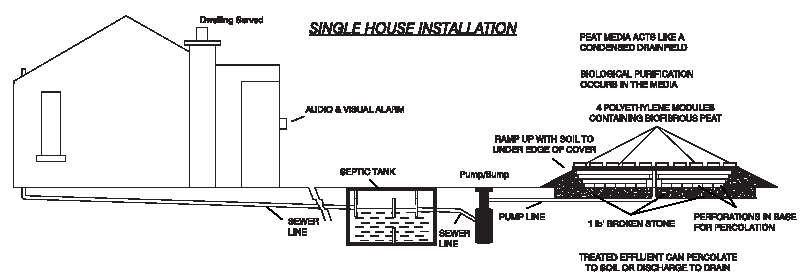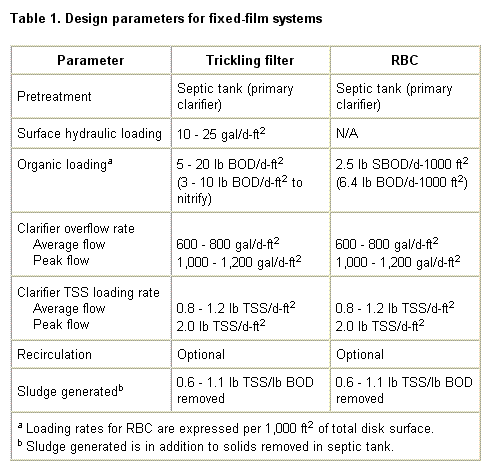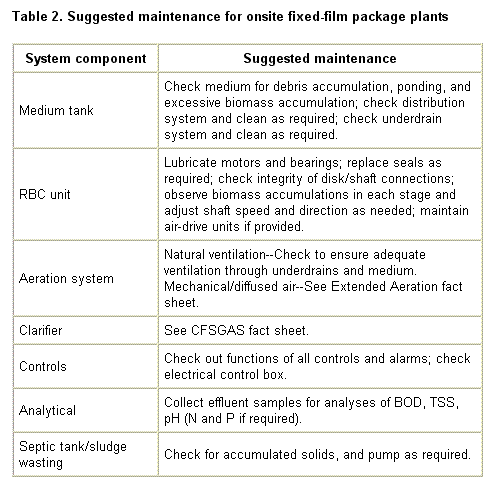

Fixed-Film Processes...
Description...
Fixed-film systems (FFS) are biological treatment processes that employ a medium such as rock, plastic, wood, or other natural or synthetic solid material that will support biomass on its surface and within its porous structure. At least
two types of fixed-film systems may be considered--those in which the medium is held in place and is stationary relative
to fluid flow (trickling filter) and those in which the medium is in motion relative to the wastewater (e.g., rotating biological disk). A third classification includes dual-process systems that encompass both fixed and suspended biomass together or in series.
Trickling filter systems are typically constructed as beds of media through which wastewater flows. Oxygen is normally provided by natural or forced ventilation. Flow distributors or sprayers distribute the wastewater evenly onto the surface
of the medium. As the wastewater moves by gravity through the medium, soluble and colloidal organic matter is metabolized
by the biofilm that forms on the medium. Excess biomass sloughs from the medium and is carried with the treated wastewater
to the clarifier, where the solids settle and separate from the treated effluent. At this point the treated wastewater may
be discharged or recycled back to the filter medium for further treatment (Figure 1).

Figure 1. Trickling filter treatment system.
A fixed-film biological treatment process that employs rotating disks that move within the wastewater is referred to as a rotating biological contactor (RBC). Developed in the late 1960s, the RBC employs a plastic medium configured as disks and mounted on a horizontal shaft. The shafts are rotated slowly (1 to 2 rpm) by mechanical or compressed air drive. For a typical aerobic RBC, approximately 40 percent of the medium is immersed in the wastewater. Anoxic or anaerobic RBCs (far
less common) are fully immersed in the wastewater. Wastewater flows through the medium by simple displacement and gravity. Biomass continuously sloughs from the disks, and some suspended biomass develops within the wastewater channels through
which the disks rotate, making the addition of a secondary clarifier necessary. The rotation of the disks exposes the attached biomass to atmospheric air and wastewater. Oxygen is supplied by natural surface transfer to the biomass. Some oxygenation of the wastewater is also created by turbulence at the disk-water interface. The use of exposed and submerged stages in multiple tanks to create aerobic and anoxic conditions may be employed where nitrogen removal is required.
Commercially available modifications primarily address the media employed, the configuration of the tankage, and the mechanical supporting systems (e.g., supplemental aeration, programmable cycling, etc.). Some FFS sludges are wasted
directly by pumping of the clarifier, whereas others convey all excess solids back to the pretreatment stage (septic tank) for subsequent removal. Lightweight synthetic media have greater surface area and are easier to install. Numerous variations ranging from extruded foam to high-specific-surface PVC and other plastic shapes are available commercially.
Typical Applications...
Fixed-film systems (FFS) are an alternative to CFSGAS for reducing biochemical oxygen demand (BOD) and total suspended
solids (TSS) from septic tank effluent to meet a higher effluent standard (Figure 2). Like CFSGAS, they can meet secondary effluent standards (30 mg/L of BOD and TSS), but they would need a minimum of effluent disinfection to be acceptable for surface water discharges. They might meet onsite water reuse requirements as long as the effluent is distributed below the ground surface. Some data support the potential for soil absorption field infiltrative surface reduction following FFS, but caution is urged regarding ground water quality protection from use of such reductions. FFS can also be used as part of a nutrient reduction treatment train. FFS provide an aerobic oxidation step in those sequences.

Figure 2. Fixed film system using peat moss as a treatment medium.
Design Assumptions...
Design guidelines for fixed-film systems are given in Table 1. FFS package units should be constructed of noncorrosive materials. Some are installed aboveground on a concrete slab with proper housing to anticipate local climatic conditions.
The units may also be buried underground as long as access is provided to all mechanical parts, control systems,
underdrains, distribution system, and water surfaces. All electric components must meet NEC code and should be waterproofed and housed from the elements. If natural ventilation is required for aeration, proper design and construction must be considered to ensure adequate oxygen transfer. Pumps, drives (for rotating units), and other mechanical devices should be designed for continuous heavy-duty use and climatic conditions. Access and drainage capability should be provided to underdrains and distribution systems because they may become clogged over time. Alarms that alert homeowners or management entities should be provided to warn of system malfunctions.

Onsite RBC package units should also be constructed of noncorrosive materials. Disk shafts and bearings and drives should be designed for heavy-duty use since they will be abused by the corrosive atmosphere generated by treatment processes and climatic conditions. Access should be provided to bearings, drives, and disks for maintenance. RBC units should be covered and insulated against cold weather and sunlight. Proper ventilation of the unit is necessary to ensure adequate oxygen transfer.
Performance...
Typical trickling filters and rotating medium systems currently available should be capable of producing effluent BOD and
TSS concentrations of 5 to 40 mg/L. System reliability is somewhat better than suspended growth package plants because of
the more effective capture and control of suspended solids. Nitrification is achievable at low loading rates in warm climates. Factors affecting performance include influent wastewater characteristics, hydraulic and organic loading, medium type, maintenance of optimal dissolved oxygen levels, and recirculation rates. The process is characteristically vulnerable to climatic conditions because of the cooling effect of the wastewater as it passes through the medium. Proper insulation, reduced effluent recirculation, and improved distribution techniques can lessen the impact of cold temperatures. Limited denitrification has been noted in nitrifying filters when oxygenation is poor and within dead zones (anaerobic portions) of the filter. Fecal coliform reductions are 1 to 2 logs. Nitrogen removal varies from 0 to 35 percent, while phosphorus
removal of 10 to 15 percent might be expected.
Combined fixed-growth/suspended-growth package units are commercially available and are generally valuable in treating high-strength wastewaters. These "high-biomass" units can be organically loaded at much higher rates than either fixed-film or flow-through suspended growth systems. They are covered in the fact sheet on CFSGAS.
Management Needs...
With proper management, RBC package plants are reliable and should pose no unacceptable risks to the homeowner or the environment. If not properly managed, however, the process can result in either premature failure of subsurface systems or environmental damage through the production of poor-quality effluent that may pose public health risks. Odors and filter flies may also create an environmental nuisance. Although there are benefits to RBCs, they do not come without some cost.
The mechanical complexity of some proprietary systems causes them to require more management attention. Additional
management is needed when disinfection and surface discharge are used.
The manufacturer normally fixes the pumping and recirculation rates for fixed-film systems, and the rates require minimal adjustments once performance objectives are attained. Sludge wasting from the clarifier to the septic tank is normally fixed by timer setting and requires occasional adjustment to avoid biomass buildup. Where mechanical or diffused aeration is employed, complexity and required frequency of inspection increase. The most frequent need is to remove solids from the distribution system. Other maintenance requirements are listed in Table 2.

Fixed-film units are also operation and maintenance intensive. Startup of the unit does not require seeding with bacterial cultures and may require 6 to 12 weeks for effective performance depending on the season. This makes them unsuitable for seasonal application. Most operating parameters in package systems cannot be controlled by the operator. The process is less labor-intensive than extended aeration (CFSGAS) systems, but it also requires semiskilled management personnel. Based on limited data on these systems, it is estimated that 4 to 12 person-hours per year plus analytical services should be sufficient. Power requirements depend on the package system selected but may range from 1 to 8 kW-h/day. Sludge production
is 0.6 to 1.0 lb TSS/lb BOD removed over and above normal septic tank sludge (septage) production. Long power outages can be particularly damaging to RBC units, and any FFS will become odiferous under these conditions.
Inspections are recommended three to four times per year, with septage pumping (solid wasting) as needed based on inspection results. Routine maintenance requirements for onsite fixed-film systems are provided in Table 2; certain tasks may not be required based on system design. For example, servicing of the final clarifier may be less critical if solids separated in the clarifier are returned to the primary settling chamber (septic tank). Field experience on operation and maintenance for these units has not been as well documented as for CFSGAS.
Risk Management...
Fixed-film systems also require a minimum of effluent disinfection to meet surface water discharge requirements. They are more susceptible to extreme cold than CFSGAS but less sensitive to shock loading and influent variability. A prolonged interruption of electric supply will result in odors. Filter flies may also be a nuisance with these systems if vents are
not properly screened.
Costs...
Observed costs are highly variable depending on climate, location, onsite aesthetic requirements, and many other factors.
The cost of power should be in the range of $100 per year for RBC units and $35 per year for trickling filters. Capital (installed) costs of $9,000 to $14,000 are typical. A management contract (estimated at about $100 to $200 per year) is recommended.






